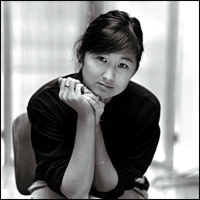The
Memorial
and its Creator

Maya Lin
Maya
Ying Lin was born in 1959 in

The Design Itself
The
Vietnam Veterans Memorial was founded by Jan Scruggs, who served in

Maya’s
design, which is a piece of visually stunning art itself, "is welcoming in its open-ended, book-like form, and yet
disconcerting to those who realize that to read the names is to stand below the
horizon - six feet under - conversing in the space of the dead4." "As you descend the gradual path along
the wall and reach the vertex, you realize that one wing of the black wall
points straight at the tall, white Washington Monument a mile or so off, and
the other at the Lincoln Memorial, visible through a screen of trees about 600
feet away. In making this descent you feel you're entering a cloistered space,
set off from the busy surroundings. Streets and skylines disappear to leave you
alone with the wall and its names." Next
to each name inscribed in the granite is either a diamond, if the person was
killed in action or a cross if the person is missing in action. "Once you reach the vertex, as you pass the
angle and begin to climb, you feel yourself emerging again into the world of
noise and light after a meditative experience3." The list starts and ends at the vertex,
beginning at the date 1959 (with first two names listed from the date of July
8, 1959) and the inscription (IN HONOR OF THE MEN AND WOMEN OF THE ARMED FORCES
OF THE UNITED STATES WHO SERVED IN THE VIETNAM WAR. THE NAMES OF THOSE WHO GAVE
THEIR LIVES AND OF THOSE WHO REMAIN MISSING ARE INSCRIBED IN THE ORDER THEY
WERE TAKEN FROM US.) It then proceeds in
chronological order, according to the date of casualty, within each day the
names are alphabetized2.
In
coming up with this design Maya knew she had to ask herself “What is a
memorial’s purpose in the 20th century.” She wanted this memorial to be special
because she knew of the great human loss.
She wanted to show that, “The cost of war is these individuals and we
have to remember them first.” Maya
wanted the visitors of the memorial to feel like they were alone and that they
were at one with the individuals on the wall.
She wanted them to be able to accept death, because “It’s only when you
can accept the pain; it’s only when you can accept the death can you then
overcome it5.”

Response
When
the design was first revealed to the public many people found it visually
stunning. Grady Clay, one of the jury
members judging the competition, said “The longer we looked at the design, the
deeper we saw into it and the more profound the statement was. The longer I looked the more convinced I was
that it was unquestionable the one5.” However, practically every detail about the
wall was debated. Lin knew that the
journey ahead of her would be hard and that she undoubtedly would be the center
of criticism, because not only was she not a Veteran but she was Asian. Some people made racial jokes and comments
toward Lin on the subject. A small group
of veterans even said that the wall was an ugly black scar in the earth
reminding them every time of the pain and suffering5. Lin chose black granite because when
polished, it is reflective. But
opponents objected2. Eventually peace was made, and to appease
those who had problems with the wall, a flag and statue were put near the wall,
in the park1.

Click
here for the Bibliography Page
If anyone has any questions or comments please
Email me at cmg2188@sbcglobal.net